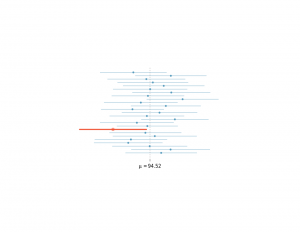Suppose that a scalar is related to a
vector,
and a disturbance term
according to the regression model.
In this article, we will study the estimation and hypothesis testing of when
is deterministic and
is i.i.d. Gaussian.
1. The Algebra of Linear Regression
Given a sample of T values of and the vector
, the ordinary least squares (OLS) estimate of
, denoted as
, is the value of
which minimizes the residual sum of squares (RSS).
The OLS estimate of , b, is given by:
The model is written in matrix notation as:
where is a
vector,
is a
matrix,
is a
vector and
is a
vector.
Thus,
Similarly,
where is defined as:
is a projection matrix. Hence it is symmetric and idempotent.
Since is the projection matrix for the space orthogonal to
,
Thus, we can verify that the sample residuals are orthogonal to .
The sample residual is constructed from the sample estimate of which is
. The population residual is a hypothetical construct based on the true population value of
.
The fit of OLS is described in terms of , which is defined as the ratio of squares of the fitted values (
to the observed values of
.
2. Assumptions on X and u
We shall assume that
(a) X will be deterministic
(b) is i.i.d with mean 0 and variance
.
(c) is Gaussian.
2.1. Properties of Estimated b Under Above Assumptions
Since,
Taking expectations of both sides, we have,
And the variance covariance matrix is given by,
Thus b is unbiased and is a linear function of y.
2.2. Distribution of Estimated b Under Above Assumptions
As u is Gaussian,
implies that b is also Gaussian.
2.3. Properties of Estimated Sample Variance Under Above Assumptions
The OLS estimate of variance of u, is given by:
Since is a projection matrix and is symmetric and idempotent, it can be written as:
where
and is a diagonal matrix with eigenvalues of
on the diagonal.
Since,
that is, since the two spaces that they represent are orthogonal to each other, it follows that:
whenever v is a column of X. Since we assume X to be of full rank, there are k such vectors and their eigenvalue is the right hand side, which is 0.
Also since
Thus, it follows that
whenever v is orthogonal to X. Since there are (T – k) such vectors, has (T – k) eigenvectors with eigenvalue 1.
Thus has k zeroes and (T – k) 1s on the diagonal.
Let
Then,
As these s are all unity, we have:
Also,
Thus, elements of w are uncorrelated with each other, have mean 0 and variance .
Since each w has expectation of ,
Hence,
2.4. Distribution of Estimated Sample Variance Under Above Assumptions
Since
when u is Gaussian, w is also Gaussian.
Then,
implies that is the sum of squares of (T – k) independent
random variables.
Thus,
Also, b and are uncorrelated, since,
Since b and are independent, b and
are also independent.
2.5. t Tests about Under Above Assumptions
We wish to test the hypothesis that the ith element of ,
, is some particular value
.
The t-statistic for testing this null hypothesis is
where denotes the ith column and ith row element of
and
is the standard error of the OLS estimate of the ith coefficient.
Under the null hypothesis,
Thus,
Thus,
Thus the numerator is N(0, 1) and the denominator is the square root of a chi-square distribution with (T – k) degrees of freedom. This gives a t-distribution to the variable on the left side.
2.6. F Tests about Under Above Assumptions
To generalize what we did for t tests, consider that we have a matrix that represents the restrictions we want to impose on
, that is
gives a vector of the hypothesis that we want to test. Thus,
Since,
Thus, under ,
Theorem 1 If
is a
vector with
and non singular
, then
.
Applying the above theorem to the vector, we have,
Now consider,
where sigma has been replaced with the sample estimate s.
Thus,
In the above, the numerator is a distribution divided by its degree of freedom and the denominator is a
distribution divided by its degree of freedom. Since b and
are independent, the numerator and denominator are also independent of each other.
Hence, the variable on the left hand side has an exact distribution under
.
